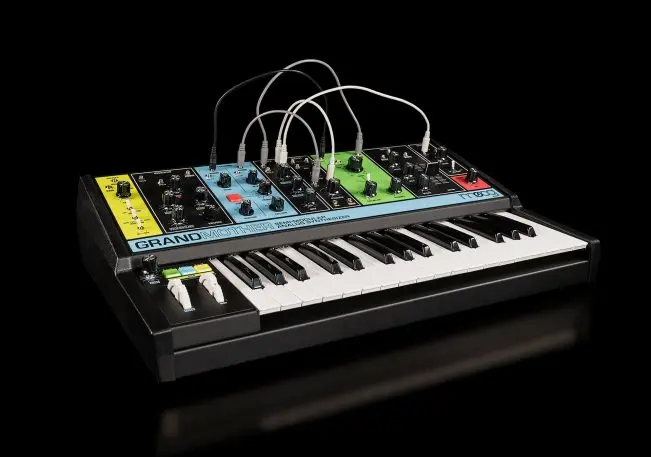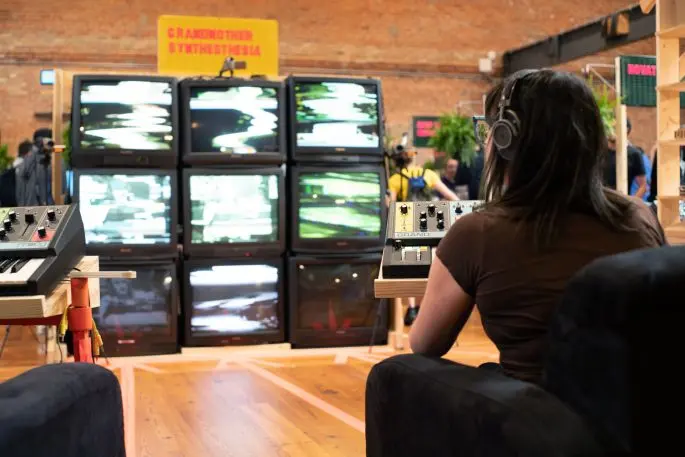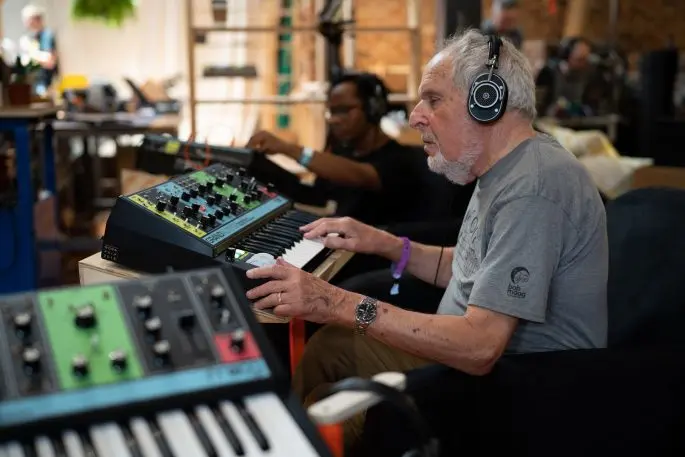These first few decades of the 21st century have seen some of the most groundbreaking pieces of music technology, including a range of new analog modular synths. The legendary Moog Music itself has evolved, returning to modular synth design even as it moves into the future, with pieces of semi-modular kit like the Mother 32 and the DFAM drum machine. The company also recently manufactured 40 new units of its Moog Synthesizer IIIp, a gorgeous analog machine released in 1969 and used by the likes of pioneering synthesis master Wendy Carlos, experimental musician Isao Tomita, Giorgio Morodor, and even The Beatles. Given that it cost $7,985 back then, the new price is kind of a bargain: $35,000.
In late May, the Asheville, North Carolina-based company released its latest—and most accessible—semi-modular analog synth yet, the Grandmother. Inspired by the Mother 32, but also by the circuitry of Moog’s massive vintage modular systems, it offers users the option to use patch cables and separate specialized sound modules.
But the $999 Grandmother is different from those other systems: It doesn’t require users to use any external patches. That makes it a breeze even for synth novices to quickly whip together some notes, program sequences, and tweak knobs and create instantly colorful soundscapes—which can, of course, then be made even more colorful and complex by patching its various modules together.
As for its looks, several of the modules are are demarcated by colorful designs that harken back to the look of Moog’s 1970s and 1980s products, like the Rogue and Realistic MG-1 keyboard synthesizers. The Grandmother debuted at this year’s Moogfest, an annual gathering in Durham, North Carolina, where electronic music, art, and technology are celebrated. While the synthesizer screams retro with its color-coded blue, yellow, green, and red modules, it’s also musical out of the box. Indeed, it’s very much a music-making machine, even before one begins patching the modules together with cables to create more adventurous and complex sounds.

As cool as Eurorack modular rigs can be, pieced together from different brands, with different circuitry and sonic textures, the resulting music can occasionally sound oddly homogeneous. The Grandmother, on the other hand, is a machine that emphasizes musical soundscapes over more procedural electronic music, without sacrificing the modern Eurorack modular community’s love of patchable flexibility.
Trent Thompson, product marketing manager at Moog Music, confirmed that the Rogue and MG-1 were, as some Moogfest attendees had suspected, big inspirations for the Grandmother. People look back on those synthesizers fondly, remembering them as fun and easy to use. The Grandmother is designed both inside and out to carry on this tradition, but in a semi-modular way.
Sounds “different from anything we’ve ever done”
With the Mother-32, Moog wanted to make an instrument that people could play immediately; and once they grew comfortable with it, they could begin patching its various circuits together, and eventually connect it to other modular systems. The Grandmother exists in a similar realm. While Moog doesn’t bill this new synthesizer as a learning tool for modular synthesis, its circuitry and form factor make it a comfortable entry point into the modular world.
“The Rogue and the MG-1 were a big part of the Grandmother’s form factor, as were the pitch and mod wheels,” Thompson explains. “They were also some of the inspiration for the colors, although the blue module color came from the Moog Sonic-6. We wanted people to look at it and feel like they could have fun with it, because so often people see a synthesizer and feel like it’s not for them. We wanted something that was fun and looked fun, but could still be really deep.”

Amos Gaynes, a product development specialist and a lead engineer at Moog Music, explains that the younger generation that annually populates Moogfest had never been able to get their hands on Moog’s large format vintage modular systems, even with the company’s recent reissues. And so the company began thinking of what it might sound like to work with these high voltage, full bandwidth modular circuits that are straightforward and direct.
“The clarity and power that you get out of the circuits, and the limitless depth of the modulation, there is something really special about it,” says Gaynes. “People have come up to us and talked about their revelatory experiences with those original modular systems, which really opened our eyes to what the magic was in those circuits.”
“At the same time, those instruments, the Model 15 and System 55, were really only available in limited numbers to a small group of people,” he adds. “What we were doing with the Mother series is casting a much broader net, and being much more accessible to people. So it made sense to bring these two things together” in an easy-to-use keyboard system.

The Grandmother’s musicality has a number of origins. As Gaynes notes, when an instrument inherently sounds good, beautiful, and pleasing to the ear, “it creates a reward feedback loop, where the player does something and it makes them smile, so they do more of it.” The Grandmother’s basic, rich, and satisfying sonics create a supportive environment where the player is able to quickly make beautiful music.
“With Grandmother, as far as its origins sonically, the oscillators are from the same lineage as the DFAM and Mother-32, but the rest of the instrument is actually heavily inspired by and based on our large-format modular synthesizers,” Trent Thompson says. “So, the filter is based on the filter that is in our large format modular systems. Actually, even the spring reverb is inspired by those large format modular circuits, and it really comes together nicely.”
The spring reverb is, in and of itself, a rarity in new synthesizers. Spring reverb is a type of reverb that uses tiny metal springs to create echoes of varying lengths and timbres, the type of reverb heard on those early rock-and-roll records, particularly surf rock. The Grandmother’s spring reverb module isn’t something new—it was inspired by the synth maker’s early modular systems, like the aforementioned IIIp.
“It sounds different than anything we’ve ever done,” Thompson adds. “It sounds familiar, but it’s lush, velvety, and very musical.”

Creative limitations
Gaynes also credits the Grandmother’s simplicity, as well as the directness of its controls layout and the way the pre-patched signal flow is set up, with giving it a “really wide sweet spot.” As a result, almost everything that is dialed in can be rewarding.
In synthesizer engineering, when all sonic possibilities are known, there is a tendency to include them all. But Gaynes says too many controls and options on the surface can create an instrument that might be more bewildering than inspiring.
“There was a very conscious design effort with this instrument, with the color, the spaces in between the controls, and limiting what controls were available, to help creative limitations,” says Gaynes. “Limitations that support the creative process. Don’t put in any limitations that are frustrating, but draw a line and create something that is really focused and clear, and keep it as easy, streamlined, and accessible as possible.”
But when players want to get more complex with their sound design, they can. This is where players will want to begin patching the Grandmother’s modules together.
With the Utilities module, for instance, Moog didn’t pre-patch it into the signal flow. That means that players have to patch it to other modules to exploit its modulation capabilities.
“The attenuator module on there is great for when you want to fine-tune a signal,” says Gaynes. “And of course the high-pass filter is an extra shaping module that works just as well on control voltages as it does on audio.”
Related: Moog Let Its Engineers Spend 10 Months On An Art Project
“It does band pass filters, and it’s great for percussion synthesis,” adds Gaynes. “If I’m trying to do hi-hats, I’ll take noise and patch it through the high-pass filter to take out the low end of the noise to get a crispy high-end sound. There are lots of tricks like that with the Utilities module if you want to be sophisticated—but it’s out of the way if you don’t need it.”
The Grandmother also readily patches into Eurorack modular rigs, while each individual modular element can be used completely on its own. That way a player can bypass Grandmother’s complete signal chain while creating a complex arrangement using other external modules.
One could, for instance, decide to only use the Grandmother’s Voltage Controlled Amplifier (VCA), which lets a player use voltage to control how much signal is allowed through to the output of the module. To do this, the player patches their other external oscillator (the sound source) and filter (for sound shaping) modules into and out of the Grandmother’s VCA module. The VCA can also be triggered with an independent envelope Eurorack module (for attack, decay, sustain, and release—variables in how long a given note rings) by patching into the Grandmother’s VCA control input.

Players can also trigger audio coming from an independent Eurorack module’s oscillator, for example, by pressing the keys, or by using its sequencer or arpeggiator, while also using the Grandmother’s filters and other modulation parameters. And if a player wants to patch only into the Grandmother’s filter, that can be done by patching directly into the Filter’s input and out through its output. This means a player is essentially “breaking” the synth’s normal signal path, generating a sound with an external Eurorack module, but sculpting it with the Grandmother’s filter the way a guitar player augments their instrument with effects pedals.
Related: Moog Is Reissuing A Legendary 1960s Synthesizer Design–For $35,000 A Pop
“You’re able to use those modules completely independently or in combination with each other just as your own concepts of sound design lead you to explore,” says Gaynes. “So basically it’s a fully integrated and playable synthesizer but can behave like independent modules whenever you want it to.”
Maybe the Grandmother won’t fully impress the modular purists who either own original vintage systems, or want to build their rigs from the ground up with various boutique Eurorack units. But Moog seems to be going after a more amorphous demographic: people—including synth newbies—who want a flexible hybrid synthesizer.
Talking with Moog’s engineers at Moogfest, it quickly became evident that they’re not content resting on any distant or recent past laurels. The Grandmother, with its lush and musical sounds, and potential for complexity but with an eye on simplicity, allows it to be something unique in the electronic music instrument market: a playable keyboard synthesizer that’s an elegant bridge between the past and future.
Recognize your brand’s excellence by applying to this year’s Brands That Matter Awards before the early-rate deadline, May 3.
